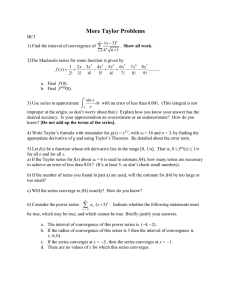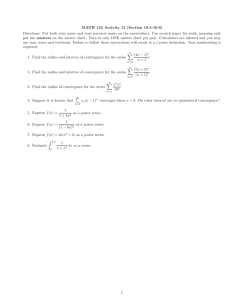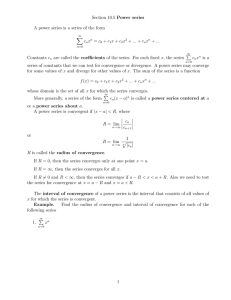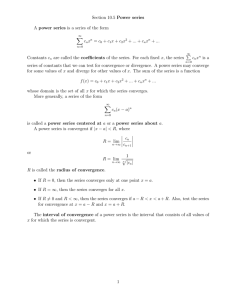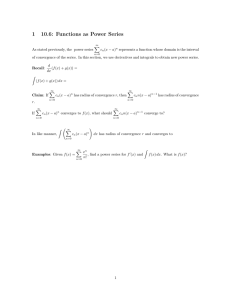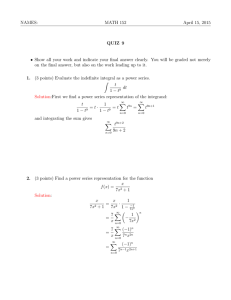MATH 152 - Recitation Quiz 9 - Spring 2015
advertisement
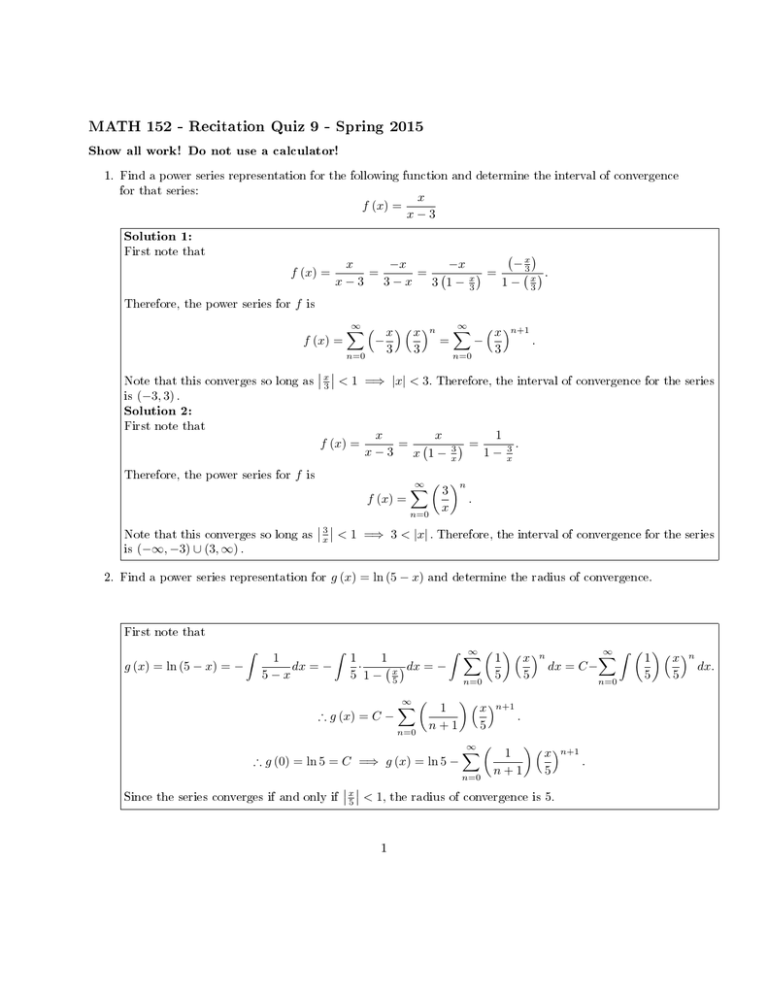
MATH 152 - Recitation Quiz 9 - Spring 2015 Show all work! Do not use a calculator! 1. Find a power series representation for the following function and determine the interval of convergence for that series: f (x) = x x−3 Solution 1: First note that − x3 x −x −x = . f (x) = = = x−3 3−x 3 1 − x3 1 − x3 Therefore, the power series for f is f (x) = Note that this converges so long as is ∞ ∞ X x x n X x n+1 − = . − 3 3 3 n=0 n=0 x < 1 =⇒ |x| < 3. 3 Therefore, the interval of convergence for the series (−3, 3) . Solution 2: First note that f (x) = Therefore, the power series for f x x 1 = 3 = x−3 1− x 1− x is f (x) = ∞ n X 3 n=0 Note that this converges so long as is (−∞, −3) ∪ (3, ∞) . x g (x) = ln (5 − x) . . 3 < 1 =⇒ 3 < |x| . Therefore, x 2. Find a power series representation for 3 x the interval of convergence for the series and determine the radius of convergence. First note that ˆ g (x) = ln (5 − x) = − 1 dx = − 5−x ˆ 1 1 dx = − · 5 1 − x5 ∴ g (x) = C − ∞ X n=0 ˆ X ∞ n 1 x 1 n+1 ∴ g (0) = ln 5 = C =⇒ g (x) = ln 5 − n=0 Since the series converges if and only if 5 1 5 x n+1 . 5 ∞ X n=0 x < 1, 5 dx = C− 1 n+1 x n+1 . 5 the radius of convergence is 5. ∞ ˆ n X 1 x dx. 5 5 n=0 3. Find the Taylor series for h centered at 2 in addition to its interval of convergence if n h(n) (2) = The Taylor series for h centered at 2 is given by: h (x) = Note now that (−1) n! . 5n (n + 5) ∞ ∞ n n X X h(n) (2) (−1) (x − 2) n (x − 2) = . n! 5n (n + 5) n=0 n=0 (x − 2)n+1 5n (n + 5) 1 lim |x − 2| < 1 =⇒ |x − 2| < 5. n = n→∞ 5n+1 (n + 6) (x − 2) 5 Therefore, the radius of convergence is 5 which means that if converges. We now have to check the endpoints. If h (x) = lim n→∞ P 1 n P 1 p-test, n+5 x = −3. If x = 7, then diverges by the Taylor series diverges when x ∈ (2 − 5, 2 + 5) = (−3, 7) , then the series then ∞ ∞ n n X X (−1) (−5) 1 = . n 5 (n + 5) n+5 n=0 n=0 Note that Therefore, since x = −3, h (x) = 1 n+5 1 n = 1. diverges by the Limit Comparison Test. Therefore, the ∞ ∞ n n X X (−1) (−1) · 5n = , 5n (n + 5) n=0 n + 5 n=0 which converges by the alternating series test. Therefore, the interval of convergence for the Taylor series is (−3, 7] . 2

